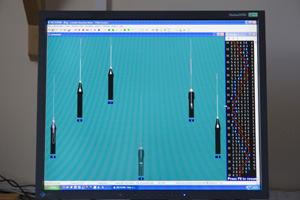On becoming a bellringer, Part Two. Guest post by CathyR
The Obsession Grows
One practice a week soon wasn't enough for me. I started going to a second practice, then a third, and occasionally a fourth, and getting experience of different bells and different teaching styles. I must admit that the suddenness and extent of my enthusiasm (ok, obsession) did take me by surprise. Becoming a bellringer, of all things, was certainly not something I'd ever expected to happen; it's rather an odd thing to be doing, isn't it .. ?? Not like photography … My husband felt the same way; being rather bemused by it all, and somewhat surprised, but going with the flow, as always. He's seen me ring, and come along on several ringing walks and outings – but remains adamant that he'll never take it up! We'll see ……
Ringing in different towers, and experiencing the foibles and peculiarities and pleasures of different bells (and different ringing chambers) did help me to feel more confident, and it was also good fun. You see all sorts …

Common Tittums
COMMON TITTUMS *
Campanile Vulgaris
Species: Nocturnal Mammal
Located: British Isles
Habitat: Bell Towers and Ale Houses
Behaviour: Strongly territorial. Usually found in bands. Emits a distinctive, strident sound.
Mind you, I always have a slightly heart-stopping moment when I take hold in a strange tower – stretch up, good grip on the sally, make sure the rope's not twisted, remember to pull off with a good strong pull, all the way through … please let it be enough so it doesn't drop on the backstroke, please let me be in time with the others, please don't let me lose control and make a fool of myself ** …… – and then, phew, it's ok and (at least in rounds), I'm ringing.***
Fellow ringers are always keen to pass on their advice and hints and tips to newbies. At that stage I just knew that bob doubles would be forever beyond me, and that I'd never understand what "ringing by the treble" meant. When yet another ringer said to me "all you need to do is …", or "what I find really helpful is …..", my brain just didn't have the space to take in anything more. Then I found this, which encapsulated my feelings about lack of brain space perfectly:
"The most basic things seem to need all my brainpower, and more … After a while, sometimes a long while, and if I try hard enough, I find that the basics of whatever it is start to become more automatic. At this point, if I'm lucky, my brain has enough space left to begin thinking about other aspects of the job in hand … Doing the minimum to ring a bell well, even to rounds or plain hunting … is a very complex process. A high degree of physical coordination is required, and you also have to be able to look and listen at the same time … it takes a while to create some spare brain space for other things." ****
I love the mental stimulation and challenge of bellringing, the never-ending learning, always having something to strive for. As well as the essential rope time, I've spent many somewhat obsessive hours in front of this Beltower simulator screen.

Beltower ringing simulator
Beltower (sic) is the ringing simulator programme I have on my laptop and PC, which enables me to learn and practice any number of methods, ringing any bell, with bobs and singles, or spliced with other methods. This screen shot shows "me" centre front, with all the "ringers" at a different stage of the stroke. The panel at the side shows the changes (rows) I have rung so far; when I don't strike in the right place (by pressing the space bar) my actual position shows up in green to show just where I've gone wrong. I probably use about 1% of Beltower's functions and capability – but what an invaluable 1% that has been for me.
It's not only the learning of theory – backward hunting and Stedman whole turns, dodging and lying, point leading and fishtails, cats' ears and coat hangers, Long London and Cambridge Places …. but also the physical learning – how can I improve my bell control, so that I can ring all those new methods and fancy pieces of work? How do I improve my striking, so that my bell sounds perfectly in the right place, every time? Looking for more ways of learning and improving, I discovered that there are such things as residential ringing courses, some of which have been running for over 40 years. Total immersion in something you are passionate about, with others who feel the same way – what more could you ask of three days? I recently attended a three day course with only six students (other, large scale courses have over 100 students split between several groups). The atmosphere on these courses is just brilliant, and the learning intense and exhausting. If any of you new, Robin-inspired ringers get the opportunity to go on such a course, grab it! You'll be amazed at what you can achieve!
Bellringing has given me so much. I love the social aspect, the outings, the pub after practice, and the friendships I have developed which I know will be lifelong. Most of all, I love the synergy of bell ringing. The whole is definitely greater than the sum of the parts, and that's what makes it really special for me.
* * *
* Tittums is a particularly melodic sequence, in which the small and large bells ring alternately, ie 1 4 2 5 3 6. The sound is ti-tum-ti-tim-ti-tum.
** Because of course, what you can't (easily) do is practise in private! Ringing is a performance every time, even when it's just a regular tower practice session. Your triumphs and disasters are publicly visible, to your fellow ringing band members and onlookers, and publicly audible to the locals.
*** Most recently when visiting Southdowner in Birmingham, and being persuaded to have a go at rounds on 12! 12!! I'd never even been in the presence of 12 bells before, never mind RUNG on 12. In Birmingham CATHEDRAL!! For service ringing!!
**** John Couperthwaite "Ringing Basics for Beginners" Central Council of Church Bellringers 2008
Robin McKinley's Blog
- Robin McKinley's profile
- 7242 followers



